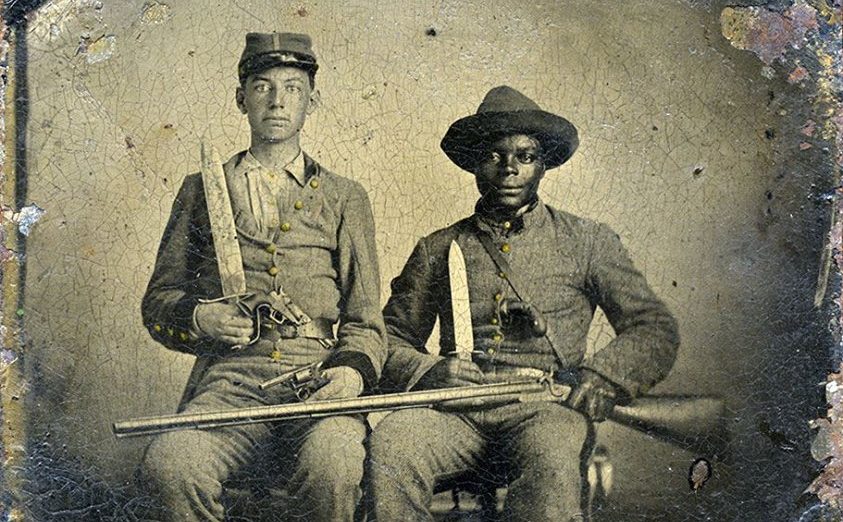I have spent hundreds of hours over the past ten years looking and thinking about this photograph (tintype) of Andrew and Silas Chandler. At times I think I have enjoyed a fleeting glimpse into the complexity of the relationship between master and slave and how it fits into the broader story of the Confederacy and slavery. At other times I look away with an overwhelming sense of futility and doubt that I will ever understand the two men staring back at me.
All we can do is approach these primary sources with questions that have undergone revision, an understanding of the relevant secondary literature, and a healthy does of humility. This is why all of us should be outraged with the author and publisher of Blacks in Gray Uniforms. Here is a situation where we can at least identify Silas Chandler’s legal status. There is no question here and there is absolutely no excuse for concluding that he served as a soldier in the Confederate army.
Let me be clear: No one, including me, has a monopoly on interpreting this image. It will always be open to a certain amount of interpretation. Our understanding of it will continue to evolve based on new evidence and the questions that we bring to bear. There will always be questions that we cannot answer, but as historians and educators we have an ethical obligation not to threat this image and their story as a means to an end.
I was reminded of this today having taken part in a conference on the challenges of interpreting the history of enslaved people at museums and historic sites around New England that was organized by The Center for Reconciliation in Providence, Rhode Island. It was an incredibly informative and moving experience. It reinforced for me the crucial point that how we interpret this specific chapter in our nation’s history impacts everything that comes later and how students and visitors approach current issues on the racial front.
This is why I am so incensed with the cavalier way in which this image and the story of Silas Chandler – the story of an enslaved man right up through to the very last days of the war – is treated in this book. This image should not be on the cover with this title. Phillip Thomas Tucker’s narrative of the relationship between Andrew and Silas does nothing to render the master-slave relationship intelligible. His claim that Silas served as a soldier defies everything we know about this individual and the broader story of the Confederacy. Again, there is no question about his legal status and yet he fails to cite it even once in the text.
Supporting these claims by suggesting that other historians are seduced by a “politically correct” agenda abandons any claim to be taken seriously as a scholar. But more importantly, it represents an abandonment of history and the obligations we assume when researching, writing, and speaking in public about the past. These records are not there simply to be manipulated to sell books or make a point about the politics of history.
The lives of these two individuals deserve to be taken into account on their own terms to whatever extent possible. But it is not simply about Andrew and Silas. This is also a betrayal of their descendants as well.
Finally and sadly enough, it lends force to the conviction of people who, for whatever reason, are committed to denying the evils of chattel slavery in America and the long history of racism.
We must do better.

Kevin,
It might not make you feel any better, but I will make sure this kind of rubbish is never sold on the battlefield in Franklin.
Thanks, Eric. I am not surprised to hear this coming from you. I just hope that Eastern Standard doesn’t end up picking up this title.
Given the photo’s misuse, I don’t think it’s helpful that Yale’s Gilder Lehrman Center is using the it in its promotion for a panel discussion on Suzan-Lori Parks’s Father Comes Home from the Wars. See http://calendar.yale.edu/cal/event/eventView.do?b=de&href=/public/cals/MainCal/CAL-ff808081-61fa57dd-0161-fd2e4df0-00006978.ics . Promotions for the play also uses it. According to an October 28, 2014 New York Times article, the play is “An epic drama that follows the fortunes of a slave who troops off to fight in the Civil War — on the Confederate side…” See https://www.yalerep.org/productions-and-programs/production/father-comes-home . Maybe the photo is being used to spark debate and conversation or clarification on the topic?
I am not happy about it either. Thanks for reminding me.
Wouldn’t it be more accurate to say “drama that follows the fortunes of a slave whose ‘owner’ takes him along as he (the ‘owner’) troops off to fight for the right to keep slaves”?
It’s not like Silas Chandler had the power to say no.
It’s a classic ploy. Find one example that might be evidence for a claim and then use it to imply that many examples are the same as one.
Yes, but this is even worse since there is no evidence for the claim that this individual served as a soldier. It’s nothing more than gross incompetency.
another ploy is to use a widely inclusive group, include the group in question and proceed to ‘ah-hah’.
a recent example is ‘colored’ confederates, including Hispanics and Native Americans, to name several, various ethnicities.
Claim ‘75,000 confederates of color’, add free and enslaved African-Americans and …voila!